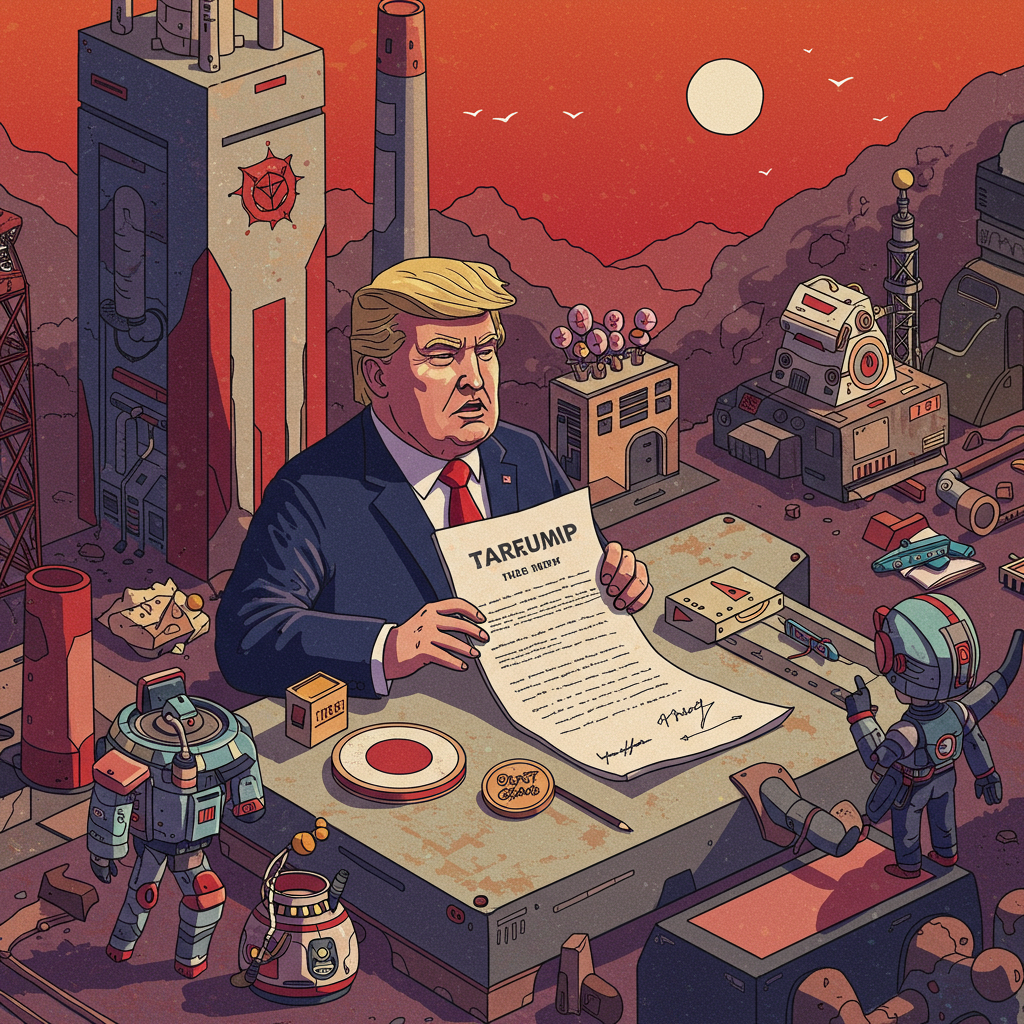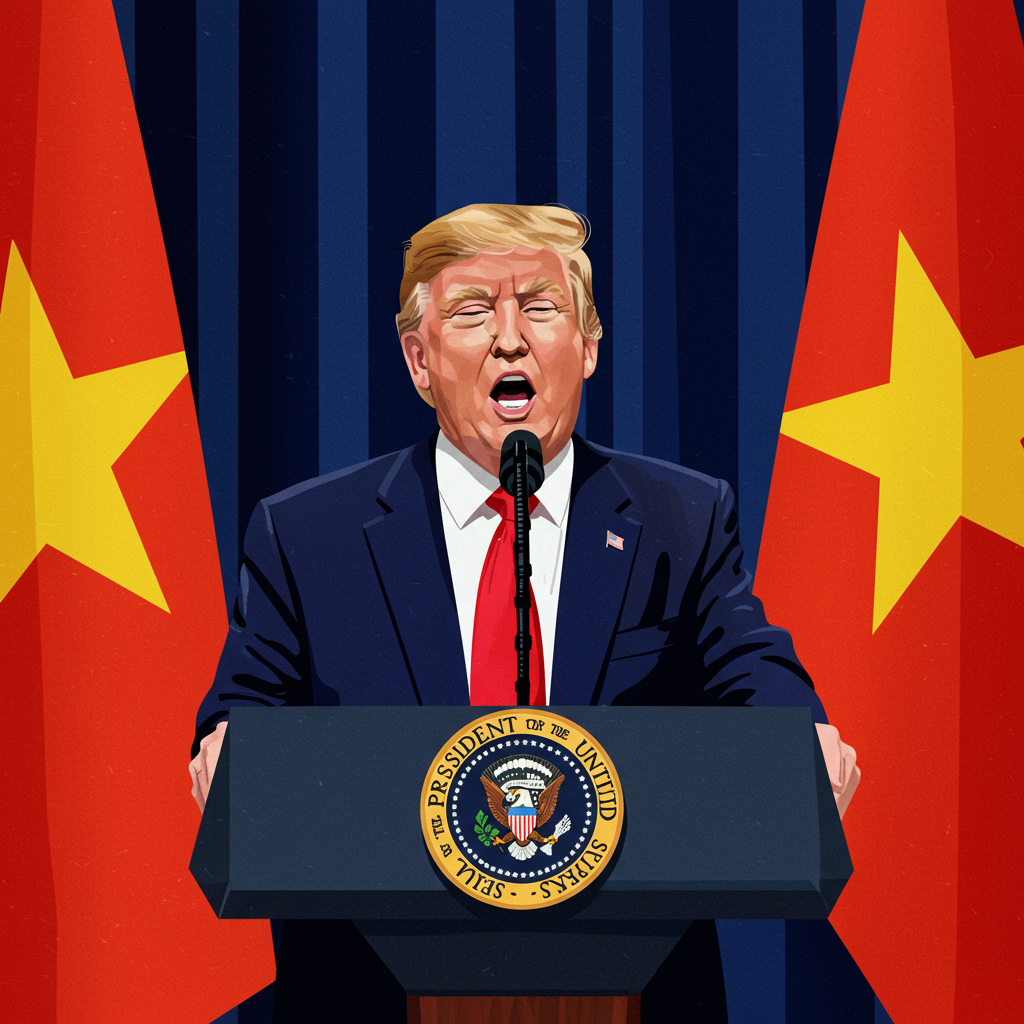A high-stakes economic standoff between the United States and <a href="https://news.quantosei.com/2025/07/02/singapore-stocks-hit-record-high-amid-mixed-trading-in-asia-as-investors-assess-feds-latest-comments/" title="Singapore Stocks Soar to Record High in Mixed Asia trade“>japan reached a critical point when former US President Donald Trump issued a stark warning. He threatened to impose significant import taxes, potentially reaching as high as 30% or even 35%, on Japanese goods unless a trade agreement was finalized by a rapidly approaching deadline. This ultimatum escalated trade tensions between two major global economies, creating uncertainty for businesses and consumers alike.
This potential tariff hike represented a substantial increase over previous duties. Earlier, Japan, along with numerous other trading partners, had faced a 24% tariff as part of broad measures announced by the US. This initial rate was later reduced to a temporary 10% for a 90-day period, intended to allow time for trade negotiations to progress. However, as this temporary pause neared its expiration date, the prospect of a much higher rate loomed large.
The Looming Deadline and Doubtful Outlook
The temporary reduction of tariffs to 10% was set to expire on a specific date, pushing negotiators against the clock. President Trump had indicated no intention of extending this crucial deadline. This rigid stance intensified pressure on Japanese officials to reach a deal quickly, despite significant hurdles remaining in the talks.
Adding to the tension, President Trump publicly expressed pessimism regarding the likelihood of an agreement being reached with Tokyo. Speaking to reporters, he cast doubt on the negotiation process, stating, “We’ve dealt with Japan. I’m not sure we’re going to make a deal. I doubt it.” Such public statements from a head of state can significantly complicate delicate diplomatic and trade discussions, signaling a lack of confidence in the process.
Japan’s Official Response and Underlying Concerns
In the face of the direct tariff threat from the US President, Japan’s initial official response was measured. During a press conference in Tokyo, a Japanese Deputy Chief Cabinet Secretary acknowledged awareness of President Trump’s remarks but adopted a cautious approach. He stated that the government would not comment on every statement made by US officials, a common diplomatic tactic to avoid being drawn into public spats.
While the official comment was understated, the threat undoubtedly caused concern within Japanese government and industry circles. Japan is a major exporting nation, with the United States being one of its largest markets. Increased tariffs could have significant repercussions for key Japanese industries, including automotive, electronics, and manufacturing.
Existing Tariffs and Points of Contention
Even before the threatened increase to 30-35%, various Japanese exports to the US already faced existing duties. At the time of the threat, most goods were subject to a 10% import levy under the temporary arrangement. However, specific sectors faced much higher rates.
Japanese vehicles and parts, a cornerstone of Japan’s export economy and a significant part of US-Japan trade, were subject to a 25% import tax. This rate itself was a point of major tension in trade discussions. Furthermore, steel and aluminum imports from Japan faced a steep 50% tariff. These existing tariffs highlighted the areas where the US sought concessions and where Japan felt its industries were unfairly targeted.
Protecting Key Sectors: Agriculture at the Forefront
Trade negotiations between the US and Japan often involve sensitive sectors in both countries. Agriculture is particularly sensitive in Japan, which historically maintains protectionist policies for its farmers, especially regarding staple crops like rice.
Japan’s chief cabinet secretary at the time had indicated a firm stance on protecting domestic agriculture. He stated that Japan would not make concessions in farming that could harm the country’s farmers simply to secure an agreement with Washington. This position directly conflicted with known US objectives in trade talks, which typically seek greater access for American agricultural products in foreign markets.
Trump’s Specific Criticism: The Rice Import Issue
President Trump frequently used social media to voice his trade grievances, often targeting specific countries and products. In this context, he specifically criticized Japan’s policy regarding rice imports from the US. Using his social media platform, Truth Social, he wrote about what he perceived as unfair trade practices.
He highlighted Japan’s reluctance to accept US rice, contrasting it with what he claimed was a “massive rice shortage” in Japan. His post read, “To show people how spoiled Countries have become with respect to the United States of America, and I have great respect for Japan, they won’t take our RICE, and yet they have a massive rice shortage.” This specific focus on rice underscored the granular level at which trade disputes were being waged and the political importance placed on specific agricultural sectors by the US administration.
Broader Context: Trump’s Trade Strategy and Negotiation Outcomes
The tariff threat against Japan was part of a broader trade policy adopted by the Trump administration. This approach often involved using tariffs as leverage to force trading partners to renegotiate existing agreements or strike new ones perceived as more favorable to the US. The initial imposition of tariffs on a wide range of countries, followed by temporary pauses for negotiation, was a hallmark of this strategy.
At the outset of the 90-day pause on tariffs for various countries, President Trump had ambitiously stated he aimed to sign 90 trade agreements during that period. However, by the time the deadline with Japan was nearing, progress on this front had been limited. Notably, only the United Kingdom had managed to strike a trade deal with the United States during that specific window. This limited success rate added to the uncertainty surrounding the Japan negotiations.
Potential Economic Impacts of Elevated Tariffs
Imposing tariffs of 30-35% on a major trading partner like Japan could trigger significant economic consequences for both nations. For Japan, higher tariffs would make its exports more expensive and less competitive in the US market. This could lead to decreased sales volume, potentially impacting manufacturing output and employment in export-oriented industries. Companies heavily reliant on the US market might face difficult decisions regarding production, pricing, and investment.
For the United States, the impact would also be multifaceted. While tariffs are intended to protect domestic industries by making foreign goods more expensive, they can also increase costs for consumers. Higher tariffs on Japanese vehicles or electronics, for instance, would likely translate into higher prices for American buyers. Furthermore, US businesses that import components from Japan could face increased production costs. Such tariffs could also invite retaliatory measures from Japan, harming American companies that export goods or services to Japan. The disruption to established supply chains could also be significant.
The Auto Sector: A Recurring Flashpoint
The automotive industry often features prominently in US-Japan trade discussions due to its economic significance in both countries. Japan is a major global car manufacturer, and the US is a critical market for its vehicles. The existing 25% tariff on Japanese vehicles and parts, and the potential for this rate to rise further, posed a direct threat to Japanese auto companies operating globally, including those with manufacturing plants in the US.
Japanese automakers have invested heavily in manufacturing facilities within the United States, employing thousands of American workers. Tariffs on vehicles or parts could disrupt these integrated operations. The US objective was often to encourage more production within the US or gain greater market access in Japan for US-made vehicles, but the tariff approach created friction and uncertainty for a complex, interdependent industry.
Frequently Asked Questions
What was the specific tariff threat Trump made against Japan and why?
Former US President Donald Trump threatened to impose tariffs of up to 30% or 35% on Japanese imports. This threat was made as a tactic to pressure Japan to finalize a trade deal with the United States before a specific deadline. The US administration sought concessions on various trade issues, including access for American agricultural products and addressing the trade imbalance, particularly in sectors like automotive. The high tariff rate was intended as leverage in these negotiations.
Which specific Japanese export sectors were major points of contention in these trade talks?
Several key sectors of Japanese exports were central to the trade discussions and faced potential high tariffs. The automotive sector, including vehicles and parts, was a major point of focus, with existing tariffs at 25% and the threat of higher rates looming. Agriculture was another highly sensitive area, with the US pushing for greater access to the Japanese market, particularly for products like rice, while Japan sought to protect its domestic farmers. Steel and aluminum imports also faced significant existing tariffs.
What were the potential economic consequences for both the US and Japan if these higher tariffs were imposed?
For Japan, the imposition of tariffs at 30-35% would likely reduce demand for its exports in the US, potentially hurting its manufacturing sector, decreasing corporate profits, and possibly leading to job losses. This could slow Japan’s economic growth. For the United States, higher tariffs could result in increased consumer prices for Japanese goods, raise costs for US businesses using Japanese components, and potentially trigger retaliatory tariffs from Japan, harming US exporters. Both economies faced potential disruption to supply chains and reduced trade volumes.
Conclusion
The threat of significantly higher tariffs on Japanese imports by the United States underscored the volatile nature of trade relations under the previous US administration’s “America First” policy. As a deadline loomed, the prospect of duties reaching 30% or even 35% created considerable anxiety in Tokyo and Washington. While Japan maintained a measured official response, the potential impact on key sectors like automotive and agriculture was a serious concern. The lack of progress in negotiations, publicly doubted by President Trump himself, highlighted the challenges in bridging the gap on contentious issues like agricultural market access. This episode served as a stark reminder of how trade policy can be used as a powerful, albeit disruptive, tool in international relations, with potential economic consequences reverberating across industries and borders for two of the world’s largest economies. Staying informed on evolving trade policies is crucial for businesses and individuals navigating the complexities of global commerce.



